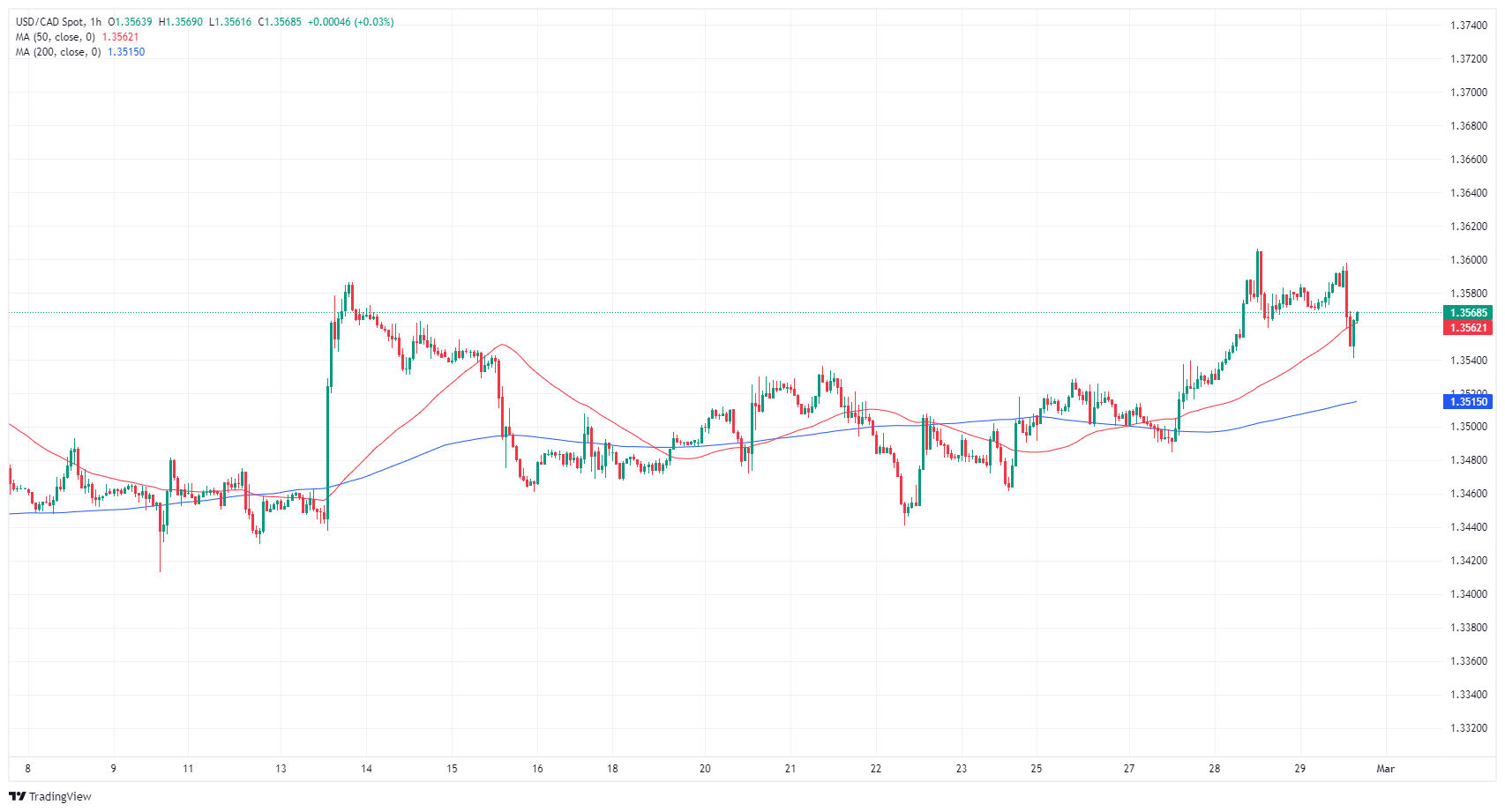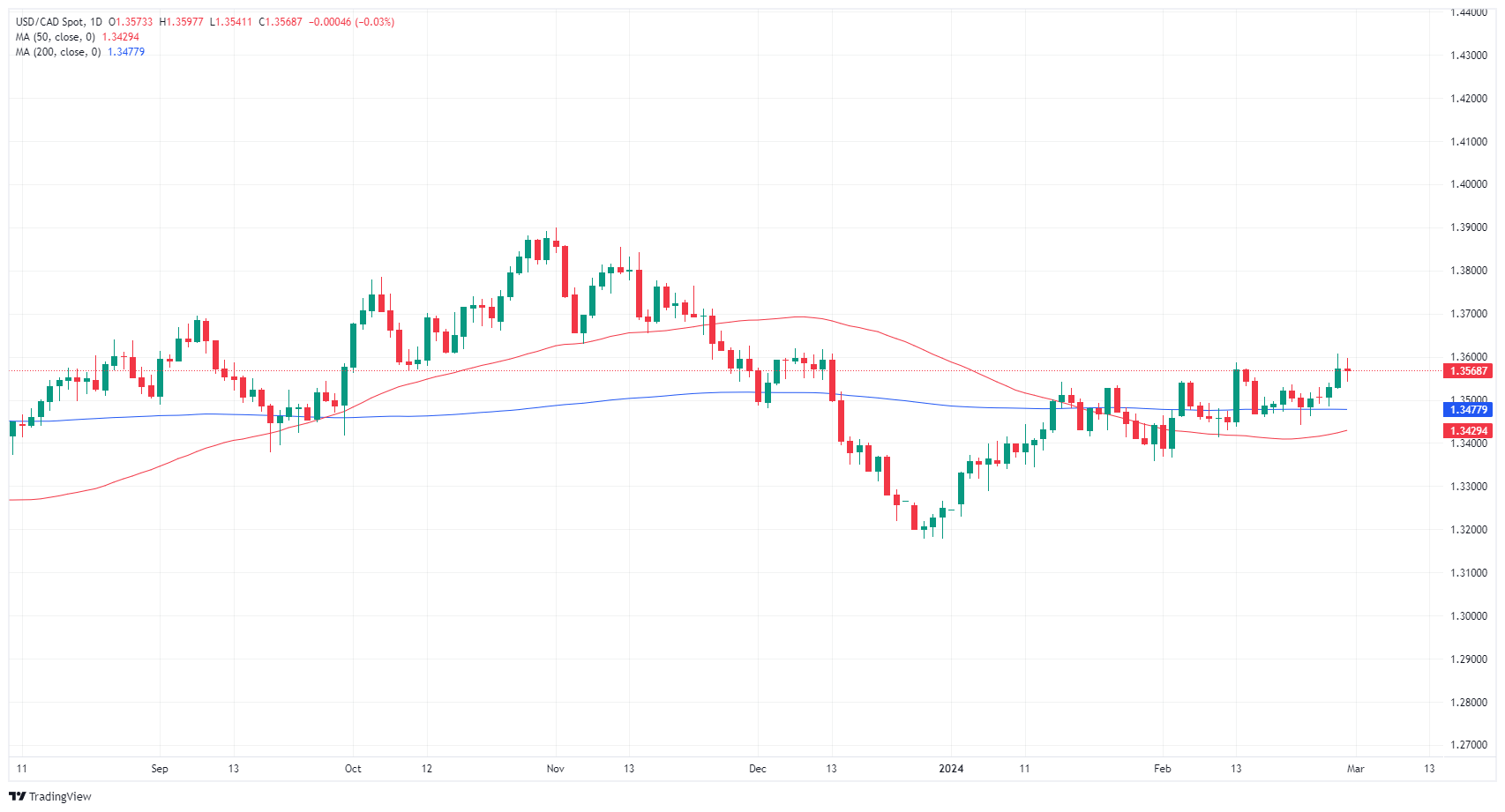- Analytics
- News and Tools
- Market News
- USD/CAD steps lower after US PCE inflation brings no surprises on Thursday
USD/CAD steps lower after US PCE inflation brings no surprises on Thursday
- USD/CAD softer on Thursday, moves are limited.
- Canada saw a mixed GDP print, and US jobless claims ticked higher.
- Friday to bring Canadian, US PMIs.
USD/CAD rose to an intraday high of 1.3597 before backsliding to 1.3541 after US Personal Consumption Expenditure Price Index (PCE) inflation figures printed exactly as markets were hoping. Annualized Canadian Gross Domestic Product (GDP) printed above expectations, but the MoM figure failed to meet expectations.
Canada still has the S&P Global Manufacturing Purchasing Manager Index (PMI) due on Friday, alongside the US S&P and ISM Manufacturing PMIs. Michigan State University’s Consumer Sentiment Index survey results are also slated for Friday. Several Federal Reserve (Fed) officials will be making appearances on Friday as well, and rate watchers will be keen to look for signs that Thursday’s PMI print drew rate cut interest from Fed policymakers.
Daily digest market movers: US PCE brings no surprises, mixed Canadian GDP limits moves
- US Core PCE printed at 2.8% YoY, exactly as expected, down slightly from previous 2.9%.
- The MoM Core PCE figure also printed at the expected 0.4%, but the previous print saw a slight downside revision to 0.1% from 0.2%.
- Canada’s Annualized Q4 GDP came in at 1.0%, above the 0.8% expected and posting a stronger recovery from the previous -0.5%, which also saw a healthy revision from -1.1%.
- US Initial Jobless Claims ticked higher for the week ended February 23, rising to 215K compared to the forecast for 210K, while the previous week saw a slight revision to 202K from 201K.
- US Pending Home Sales also declined to a five-month low, printing at -4.9% versus the forecast of 1.0%, a sharp pullback from the previous 5.7% (revised down from 8.3%).
- Friday brings the latest Canadian S&P Global Manufacturing PMI for February, which last printed at 48.3.
- Friday’s US ISM Manufacturing PMI is expected to tick slightly higher to 49.5 from 49.1 in February.
Canadian Dollar price today
The table below shows the percentage change of Canadian Dollar (CAD) against listed major currencies today. Canadian Dollar was the weakest against the Japanese Yen.
| USD | EUR | GBP | CAD | AUD | JPY | NZD | CHF | |
| USD | 0.24% | 0.21% | -0.07% | -0.18% | -0.53% | 0.14% | 0.45% | |
| EUR | -0.28% | -0.06% | -0.32% | -0.40% | -0.80% | -0.12% | 0.18% | |
| GBP | -0.20% | 0.04% | -0.27% | -0.37% | -0.72% | -0.06% | 0.27% | |
| CAD | 0.06% | 0.32% | 0.27% | -0.11% | -0.47% | 0.21% | 0.52% | |
| AUD | 0.15% | 0.38% | 0.35% | 0.07% | -0.38% | 0.29% | 0.59% | |
| JPY | 0.54% | 0.78% | 0.72% | 0.46% | 0.37% | 0.71% | 1.01% | |
| NZD | -0.15% | 0.10% | 0.07% | -0.20% | -0.31% | -0.67% | 0.34% | |
| CHF | -0.45% | -0.21% | -0.25% | -0.53% | -0.64% | -0.99% | -0.31% |
The heat map shows percentage changes of major currencies against each other. The base currency is picked from the left column, while the quote currency is picked from the top row. For example, if you pick the Euro from the left column and move along the horizontal line to the Japanese Yen, the percentage change displayed in the box will represent EUR (base)/JPY (quote).
Technical analysis: USD/CAD still up on the week despite Thursday backstep
USD/CAD is trading into familiar near-term levels after falling toward 1.3540. The pair remains capped under the week’s high of 1.3606 set on Wednesday, and intraday price action is getting bolstered by the 200-hour Simple Moving Average (SMA) nearby at 1.3515.
Thursday’s daily candlestick is notably middling on the high side of recent consolidation. The pair is drifting away from the 200-day SMA at 1.3478 and is up over 3% from the last major swing low into the 1.3200 handle.
USD/CAD hourly chart
USD/CAD daily chart 
Canadian Dollar FAQs
What key factors drive the Canadian Dollar?
The key factors driving the Canadian Dollar (CAD) are the level of interest rates set by the Bank of Canada (BoC), the price of Oil, Canada’s largest export, the health of its economy, inflation and the Trade Balance, which is the difference between the value of Canada’s exports versus its imports. Other factors include market sentiment – whether investors are taking on more risky assets (risk-on) or seeking safe-havens (risk-off) – with risk-on being CAD-positive. As its largest trading partner, the health of the US economy is also a key factor influencing the Canadian Dollar.
How do the decisions of the Bank of Canada impact the Canadian Dollar?
The Bank of Canada (BoC) has a significant influence on the Canadian Dollar by setting the level of interest rates that banks can lend to one another. This influences the level of interest rates for everyone. The main goal of the BoC is to maintain inflation at 1-3% by adjusting interest rates up or down. Relatively higher interest rates tend to be positive for the CAD. The Bank of Canada can also use quantitative easing and tightening to influence credit conditions, with the former CAD-negative and the latter CAD-positive.
How does the price of Oil impact the Canadian Dollar?
The price of Oil is a key factor impacting the value of the Canadian Dollar. Petroleum is Canada’s biggest export, so Oil price tends to have an immediate impact on the CAD value. Generally, if Oil price rises CAD also goes up, as aggregate demand for the currency increases. The opposite is the case if the price of Oil falls. Higher Oil prices also tend to result in a greater likelihood of a positive Trade Balance, which is also supportive of the CAD.
How does inflation data impact the value of the Canadian Dollar?
While inflation had always traditionally been thought of as a negative factor for a currency since it lowers the value of money, the opposite has actually been the case in modern times with the relaxation of cross-border capital controls. Higher inflation tends to lead central banks to put up interest rates which attracts more capital inflows from global investors seeking a lucrative place to keep their money. This increases demand for the local currency, which in Canada’s case is the Canadian Dollar.
How does economic data influence the value of the Canadian Dollar?
Macroeconomic data releases gauge the health of the economy and can have an impact on the Canadian Dollar. Indicators such as GDP, Manufacturing and Services PMIs, employment, and consumer sentiment surveys can all influence the direction of the CAD. A strong economy is good for the Canadian Dollar. Not only does it attract more foreign investment but it may encourage the Bank of Canada to put up interest rates, leading to a stronger currency. If economic data is weak, however, the CAD is likely to fall.
© 2000-2024. All rights reserved.
This site is managed by Teletrade D.J. LLC 2351 LLC 2022 (Euro House, Richmond Hill Road, Kingstown, VC0100, St. Vincent and the Grenadines).
The information on this website is for informational purposes only and does not constitute any investment advice.
The company does not serve or provide services to customers who are residents of the US, Canada, Iran, The Democratic People's Republic of Korea, Yemen and FATF blacklisted countries.
Making transactions on financial markets with marginal financial instruments opens up wide possibilities and allows investors who are willing to take risks to earn high profits, carrying a potentially high risk of losses at the same time. Therefore you should responsibly approach the issue of choosing the appropriate investment strategy, taking the available resources into account, before starting trading.
Use of the information: full or partial use of materials from this website must always be referenced to TeleTrade as the source of information. Use of the materials on the Internet must be accompanied by a hyperlink to teletrade.org. Automatic import of materials and information from this website is prohibited.
Please contact our PR department if you have any questions or need assistance at pr@teletrade.global.















